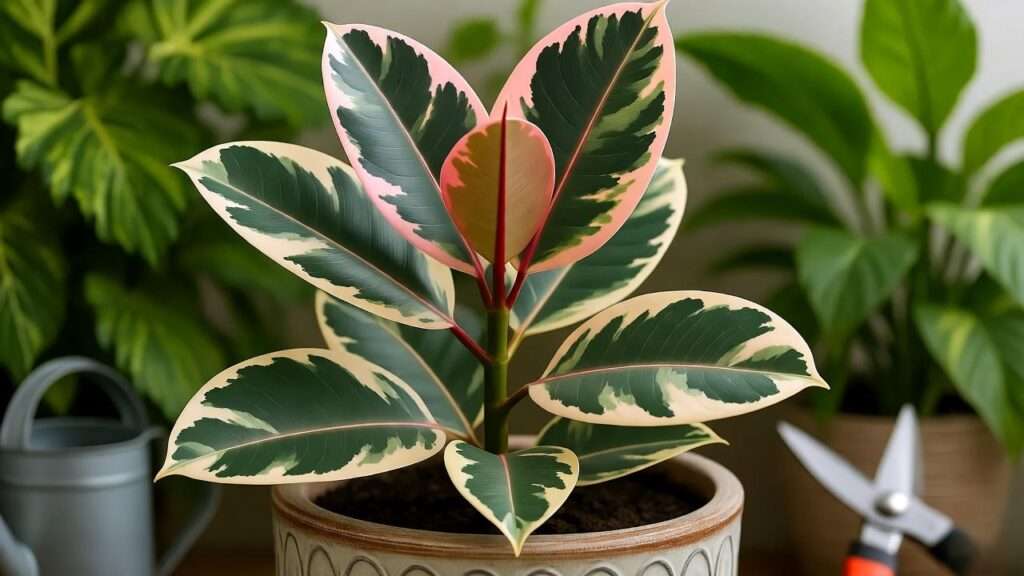Picture this: you walk into your living room, and there it is—a stunning variegated rubber plant with its creamy white, pink, and green leaves stealing the show. Its glossy foliage instantly elevates your space, but keeping it vibrant and healthy? That’s where the challenge begins. Whether you’re a seasoned plant parent or a newbie, this guide is your roadmap to mastering variegated rubber plant care. As a horticulturist with over a decade of experience nurturing tropical plants, I’ve helped countless growers keep their Ficus elastica thriving. In this comprehensive article, you’ll discover expert-backed tips on light, watering, soil, propagation, and troubleshooting to ensure your plant flourishes. Ready to transform your variegated rubber plant into a showstopper? Let’s dive in! 🌸
Understanding the Variegated Rubber Plant 🌿
What Makes the Variegated Rubber Plant Unique?
The variegated rubber plant, scientifically known as Ficus elastica, is a tropical beauty native to Southeast Asia. Unlike its solid-green cousin, the variegated version boasts stunning multicolored leaves—think creamy white, pink, or yellow patterns splashed across glossy green. Popular cultivars like ‘Tineke’ (creamy white variegation), ‘Ruby’ (pinkish-red hues), and ‘Burgundy’ (deep green with subtle variegation) make it a favorite for indoor decor. Its bold, architectural leaves add a touch of elegance to any space, from minimalist apartments to cozy homes.
Benefits of Growing a Variegated Rubber Plant
Why choose a variegated rubber plant? Beyond its Instagram-worthy aesthetic, it’s an air-purifying powerhouse. NASA’s Clean Air Study found that Ficus elastica helps remove toxins like formaldehyde from indoor air. It’s also relatively low-maintenance compared to finicky tropicals like calatheas, making it ideal for busy plant lovers. Plus, its vibrant foliage brings a pop of color to any room, enhancing both decor and mood. 🌞
Essential Care Tips for Variegated Rubber Plants 🌱
Light Requirements for Vibrant Variegation
Light is the key to maintaining those gorgeous variegated leaves. Your plant craves bright, indirect light—think near a north- or east-facing window with filtered sunlight. Too little light, and the variegation fades, leaving you with dull, green-heavy leaves. Too much direct sun? You’ll risk leaf burn, especially on delicate pink or white patches.
Pro Tip: If your home lacks natural light, invest in a full-spectrum LED grow light (I recommend a 20W model for small to medium plants). Place it 12-18 inches above the plant for 10-12 hours daily. Rotate your plant every few weeks to ensure even growth. Avoid placing it in direct sunlight, as this can scorch the leaves, especially for sensitive cultivars like ‘Ruby.’
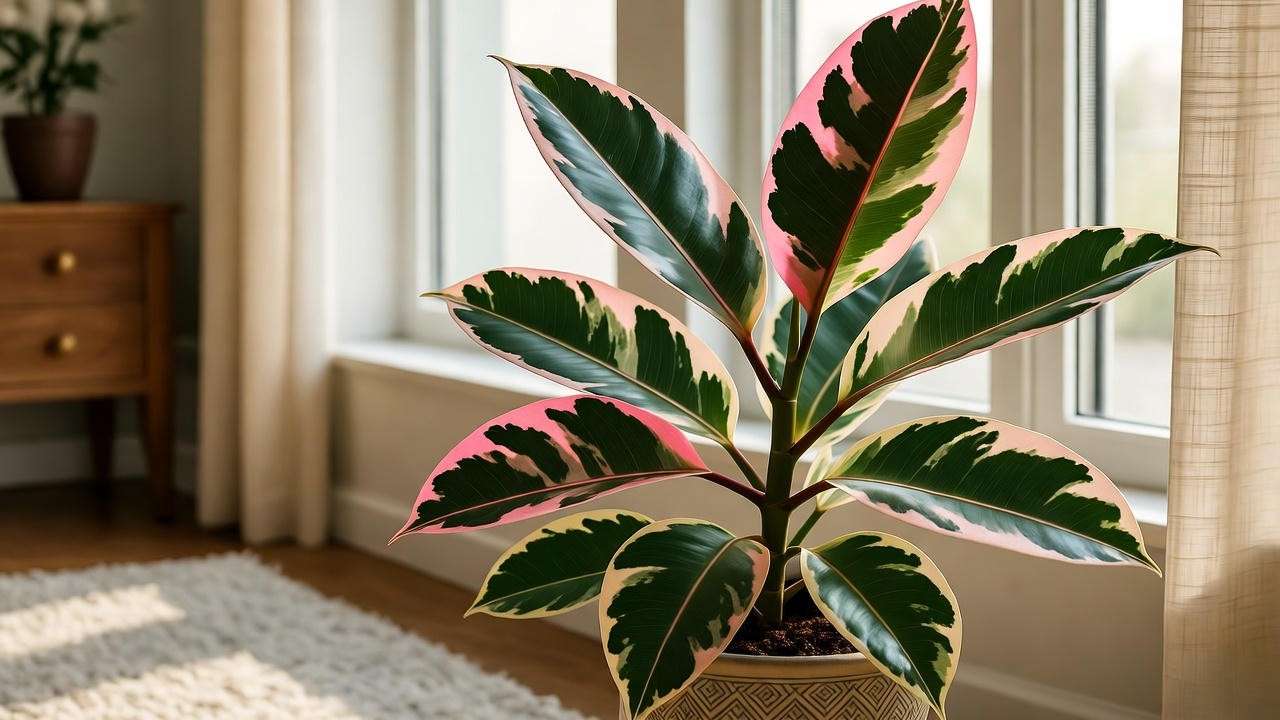
Watering the Right Way 💧
Watering a variegated rubber plant is all about balance. Allow the top 1-2 inches of soil to dry out between waterings—typically every 1-2 weeks, depending on your climate. In spring and summer, water more frequently as the plant grows. In fall and winter, reduce watering as growth slows. Use room-temperature water to avoid shocking the roots, and always ensure your pot has drainage holes to prevent soggy soil.
Common Mistakes: Overwatering is the number one killer, leading to yellowing leaves or root rot. Underwatering, on the other hand, causes drooping or crispy leaves. Check the soil with your finger or a moisture meter before watering. If you’re unsure, err on the side of underwatering—this plant is more forgiving of dry spells than soggy ones.
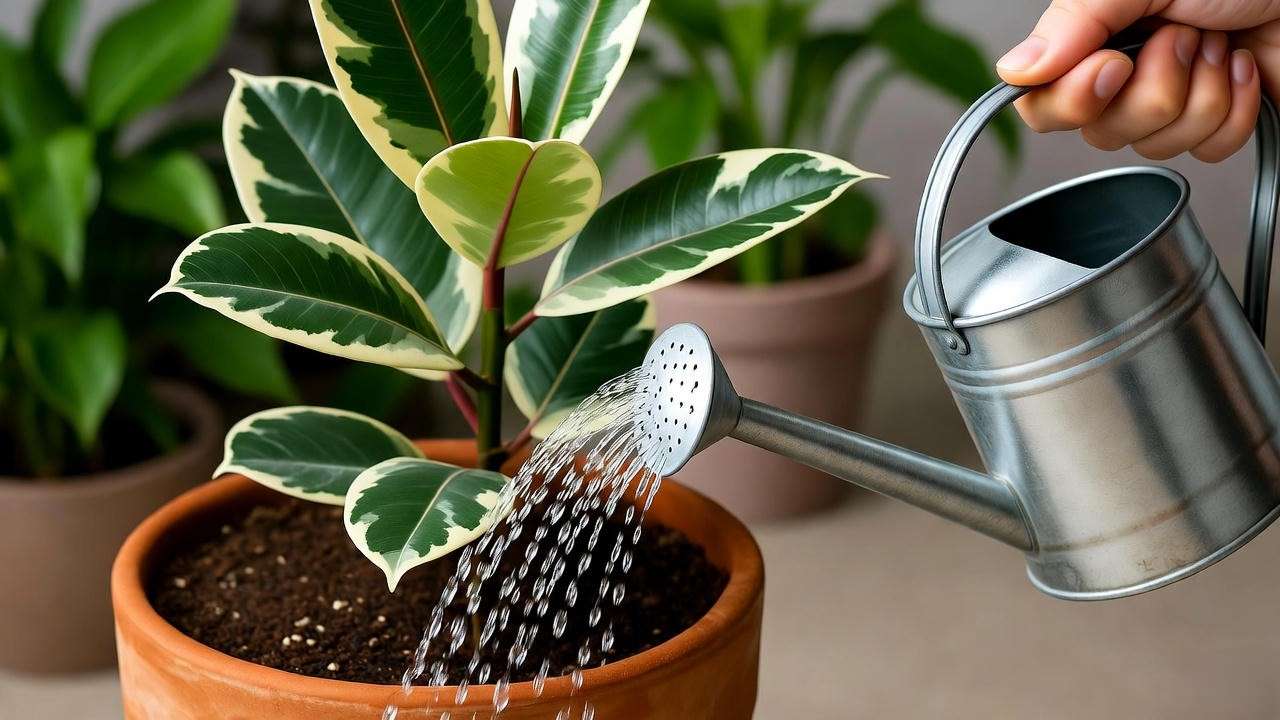
Soil and Potting Needs 🪴
A well-draining soil mix is non-negotiable for a healthy variegated rubber plant. Opt for a peat-based potting mix with perlite or orchid bark for aeration—something like a 2:1:1 ratio of peat, perlite, and pine bark works wonders. Avoid heavy, water-retaining soils that suffocate roots.
Choose a pot with drainage holes to prevent water buildup. Terracotta pots are great for wicking away excess moisture, while ceramic pots add style (just ensure proper drainage). Repot every 1-2 years or when roots start circling the pot’s bottom. Spring is the best time for repotting, as the plant is in its active growth phase. Gently loosen the root ball and use fresh soil to give your plant a nutrient boost.
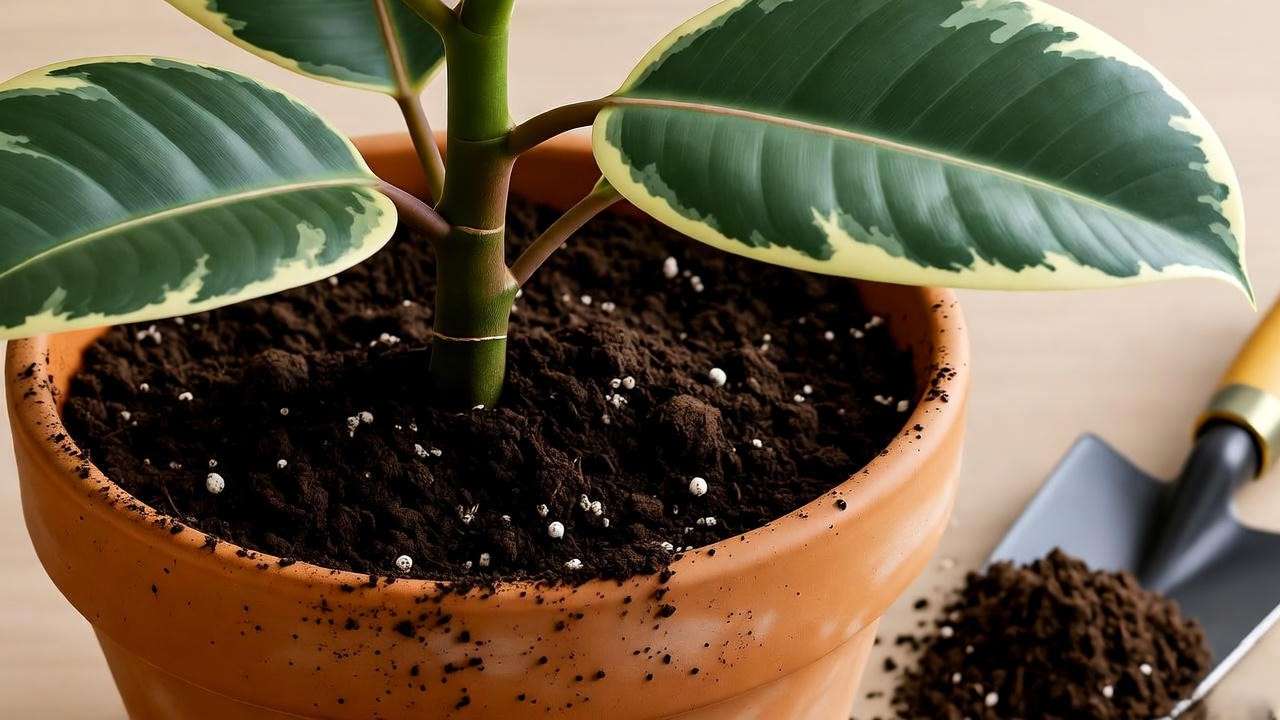
Temperature and Humidity Preferences 🌡️
Variegated rubber plants thrive in temperatures between 60-75°F (15-24°C). They’re sensitive to cold drafts, so keep them away from chilly windows or air conditioning vents in winter. If temperatures drop below 55°F (13°C), your plant may drop leaves or stunt growth.
Humidity is another key factor. Aim for 40-60% humidity to mimic their tropical origins. In dry climates or heated homes, boost humidity with a pebble tray filled with water or a small humidifier (a budget-friendly 1L ultrasonic model works well). Misting can help, but don’t overdo it—excess moisture on leaves can invite fungal issues.
Fertilizing for Healthy Growth 🌿
Feed your variegated rubber plant monthly during the growing season (spring and summer) with a balanced, water-soluble fertilizer (10-10-10 or 20-20-20). Dilute to half-strength to avoid burning the roots. In fall and winter, stop fertilizing as the plant rests.
Organic Option: For eco-conscious growers, try compost tea or fish emulsion every 6-8 weeks. Watch for signs of over-fertilizing, like leaf tip burn or salt buildup on the soil surface. If this happens, flush the soil with distilled water and reduce feeding frequency.
Pruning and Maintenance ✂️
How to Prune for Shape and Health
Pruning keeps your variegated rubber plant shapely and healthy. Use clean, sharp shears to trim leggy stems or remove yellowing leaves. To encourage bushier growth, cut just above a leaf node (where a leaf meets the stem). Spring is the best time for major pruning, as the plant recovers quickly.
Safety Note: The plant’s milky sap can irritate skin and eyes, so wear gloves and wash hands after pruning. If sap gets on your skin, rinse immediately. Dispose of pruned leaves safely, especially if you have pets or kids.
Cleaning Leaves for Maximum Shine
Dust on leaves blocks sunlight and dulls your plant’s appearance. Wipe leaves monthly with a soft, damp cloth or a mild soap solution (1 tsp dish soap per liter of water). For extra shine, use a microfiber cloth. Avoid commercial leaf shine products, as they can clog leaf pores and harm photosynthesis. Clean leaves not only look better but also help your plant breathe and grow efficiently.
Propagating Your Variegated Rubber Plant 🌱
Step-by-Step Propagation Guide
Want more variegated rubber plants for free? Propagation is easy with stem cuttings. Here’s how:
- Choose a Healthy Stem: Select a 4-6 inch stem with 2-3 leaves and a node.
- Cut and Prep: Use a clean, sharp knife to cut below a node. Remove lower leaves.
- Rooting Medium: Place the cutting in water (change every 3-5 days) or moist soil with perlite.
- Boost Success: Dip the cut end in rooting hormone (optional but speeds up rooting).
- Provide Humidity: Cover with a plastic bag or propagator to trap moisture.
- Wait and Transplant: Roots should form in 4-6 weeks. Transplant to soil once roots are 1-2 inches long.
Expert Tip: Keep cuttings in bright, indirect light and maintain high humidity (70% or more) for best results.
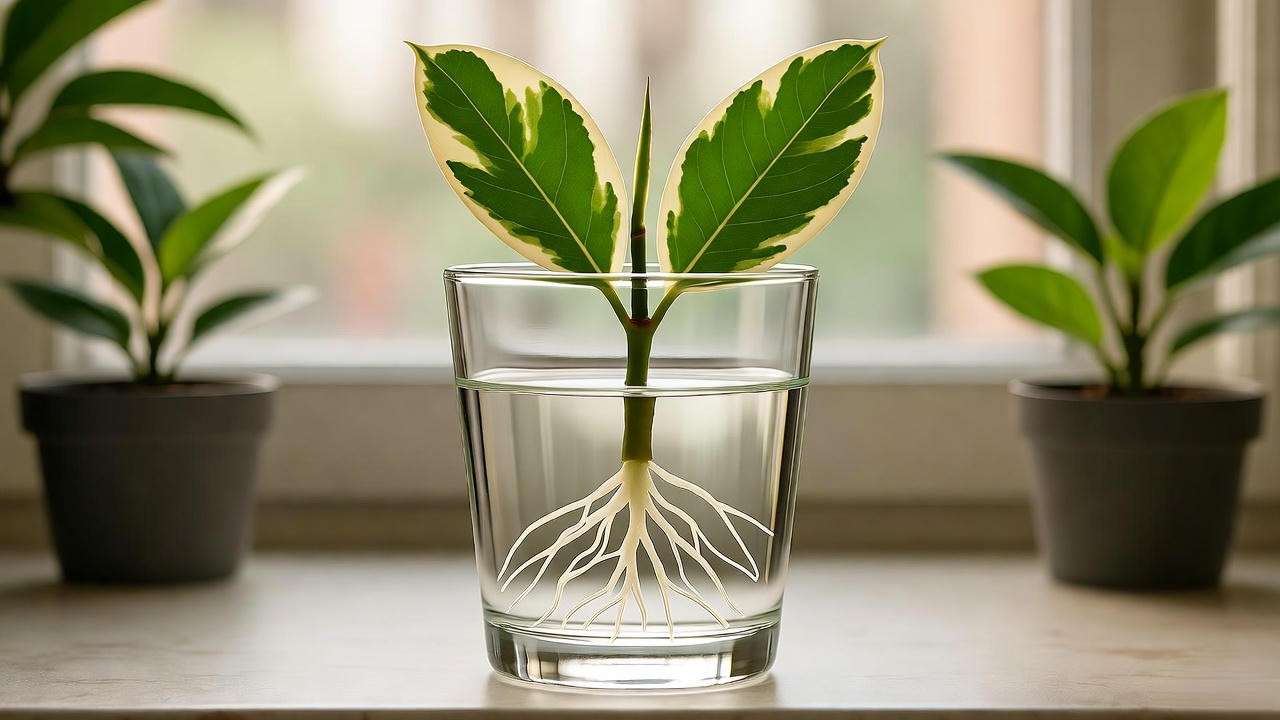
Common Propagation Mistakes to Avoid
- Overwatering Cuttings: Keep soil moist but not soggy to prevent rot.
- Unhealthy Stems: Choose vibrant, firm stems, not weak or yellowing ones.
- Low Humidity: Without enough moisture, cuttings may dry out before rooting.
Troubleshooting Common Issues 🐛
Why Are My Leaves Dropping?
Leaf drop is a cry for help. Common causes include:
- Overwatering: Check for soggy soil and improve drainage.
- Underwatering: Ensure consistent watering when soil is dry.
- Environmental Stress: Sudden moves, temperature swings, or drafts can shock the plant.
Solution: Adjust your care routine and stabilize conditions. Move the plant to a consistent spot with proper light and temperature.
Dealing with Pests
Variegated rubber plants can attract spider mites, scale, or mealybugs. Spot them early by checking leaf undersides. For organic control, spray with neem oil (1 tbsp per liter of water) or insecticidal soap every 7-10 days until pests are gone. Prevent infestations by maintaining humidity and inspecting new plants before bringing them home.
Fixing Fading Variegation
If your plant’s variegation is fading, it’s likely due to:
- Low Light: Move to a brighter spot or add a grow light.
- Nutrient Deficiency: Resume regular fertilizing with a balanced formula.
Test light levels with a light meter (aim for 1000-2000 lux) to ensure your plant gets enough brightness.
Styling Your Variegated Rubber Plant in Your Home 🏡
Creative Display Ideas
A variegated rubber plant isn’t just a plant—it’s a statement piece! Its bold, multicolored leaves deserve a display that highlights their beauty. Here are some ideas to style your Ficus elastica:
- Decorative Pots: Choose a ceramic pot in neutral tones (white, beige, or terracotta) to complement the plant’s vibrant foliage. For a modern look, try a sleek, matte black pot. Ensure the pot has drainage holes to keep roots healthy.
- Plant Stands: Elevate your plant on a mid-century-style wooden stand to create a focal point in your living room or office. A 12-18 inch stand works well for medium-sized plants.
- Corner Accents: Place your rubber plant in a corner near a window to add life to underused spaces. Pair it with a woven basket for a boho vibe.
- Companion Plants: Group with low-maintenance plants like pothos, snake plants, or peace lilies for a lush indoor jungle. Ensure companions have similar light and water needs to simplify care.
Styling Tip: Use a pot 1-2 inches larger than the root ball to give your plant room to grow while keeping the setup proportionate. Rotate the plant every month to ensure even light exposure and a balanced shape.
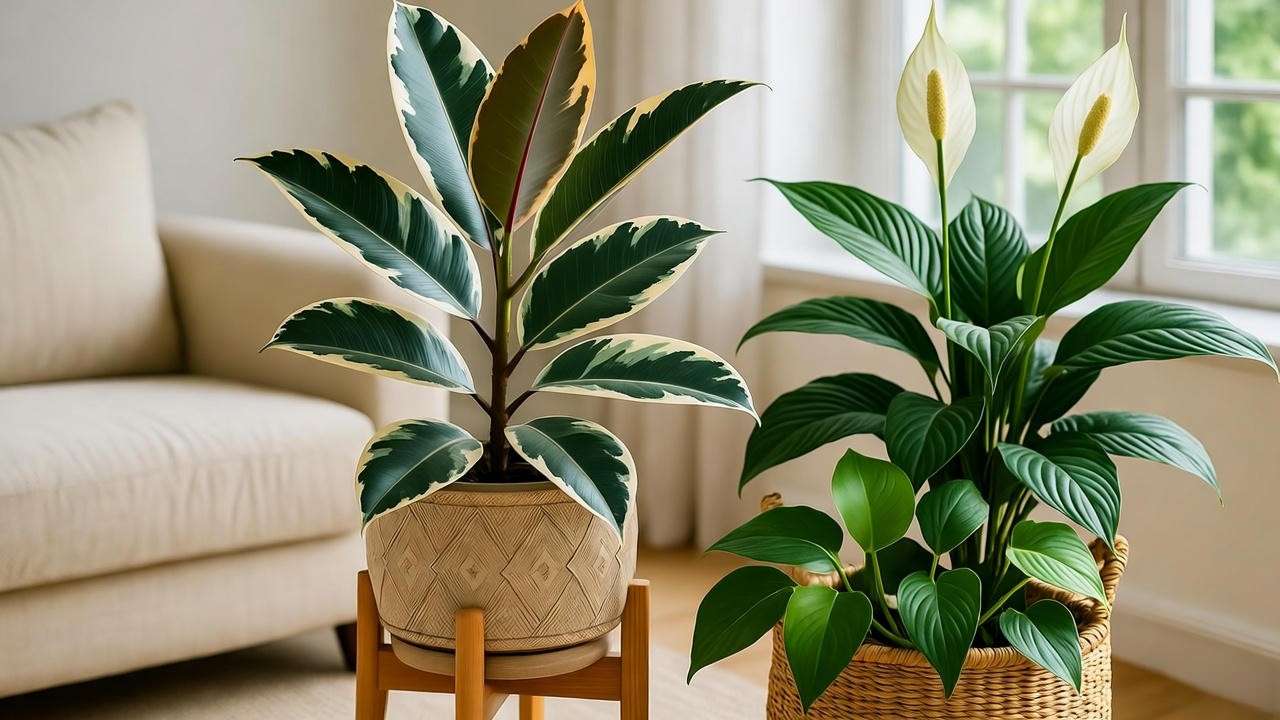
Feng Shui and Plant Placement
In Feng Shui, the variegated rubber plant is believed to bring positive energy and prosperity. Its round, glossy leaves symbolize wealth and growth. Place it in the southeast corner of your home (the wealth sector) to enhance abundance or in the east for health and family harmony. Avoid placing it in cluttered or dark areas, as this can disrupt energy flow.
For maximum impact, keep the plant healthy and dust-free—vibrant leaves amplify positive chi. Pair with a small water feature, like a tabletop fountain, to balance the plant’s wood element with water for harmony. 🌊
Expert Insights and Pro Tips 🌟
As a horticulturist who’s nurtured variegated rubber plants for over a decade, I’ve learned a few tricks to keep them thriving. Dr. Sarah Green, a renowned plant scientist, sums it up perfectly: “Variegated rubber plants thrive with consistency—stick to a routine, and they’ll reward you with stunning growth.” Here are my go-to tips:
- Rotate for Balance: Turn your plant 90 degrees every 2-3 weeks to prevent it from leaning toward the light.
- Pebble Tray Hack: Place a tray of pebbles filled with water beneath the pot to boost humidity without misting.
- Seasonal Care Calendar:
- Spring/Summer: Water weekly, fertilize monthly, and prune for shape.
- Fall/Winter: Water every 2-3 weeks, stop fertilizing, and keep away from heaters.
- Check Drainage: After watering, empty saucers within 30 minutes to prevent root rot.
Pro Insight: If your plant grows too tall, don’t be afraid to prune drastically—cutting back to 12-18 inches can encourage a bushier, more compact shape. Just ensure cuts are clean and made above a node.
FAQs About Variegated Rubber Plant Care ❓
Q: How often should I water my variegated rubber plant?
A: Water when the top 1-2 inches of soil feel dry, typically every 1-2 weeks in spring/summer and every 2-3 weeks in fall/winter. Use a moisture meter for precision and adjust based on your home’s humidity and light.
Q: Can variegated rubber plants grow in low light?
A: They prefer bright, indirect light to maintain variegation. Low light can cause fading colors and leggy growth. If natural light is limited, use a 20W full-spectrum LED grow light for 10-12 hours daily.
Q: Is the variegated rubber plant toxic to pets?
A: Yes, it’s toxic to cats, dogs, and other pets due to its milky sap, which can cause vomiting or skin irritation. Keep it out of reach or opt for pet-safe plants like spider plants if you have curious pets.
Q: How can I make my rubber plant bushier?
A: Prune above leaf nodes to encourage branching and pinch back new growth to promote fullness. Regular pruning in spring keeps the plant compact and lush.
Q: Why are my plant’s leaves turning brown?
A: Brown leaves often indicate underwatering, low humidity, or cold drafts. Check soil moisture, boost humidity with a humidifier, and move the plant away from chilly windows.
Conclusion 🌿
Caring for a variegated rubber plant is a rewarding journey that transforms your space with vibrant, tropical beauty. By providing bright, indirect light, watering thoughtfully, using well-draining soil, and maintaining proper humidity, you’ll keep your Ficus elastica thriving year-round. Whether you’re troubleshooting leaf drop, propagating new plants, or styling it as a decor centerpiece, this guide equips you with everything you need to succeed.
Ready to take your plant care game to the next level? Share your variegated rubber plant photos or questions in the comments below, or join our plant care community on social media for more tips! 🌱 Want a handy checklist? Sign up for our newsletter to download a free Variegated Rubber Plant Care Cheat Sheet and keep your plant flourishing. Happy growing! 🌸

